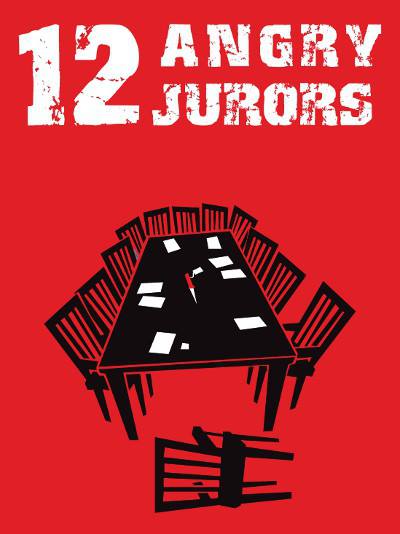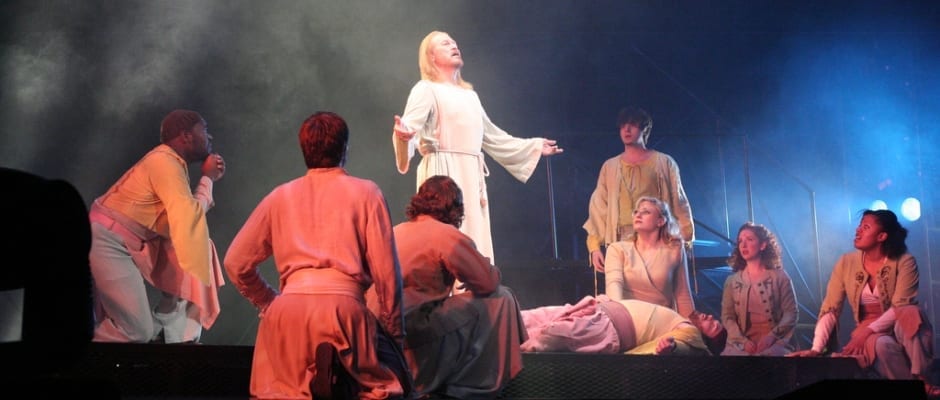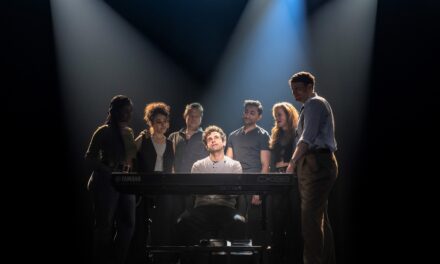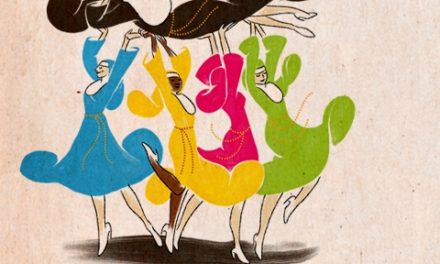CENTERVILLE — The setting is a deliberation room for the citizens serving on jury for a murder trial to discuss and argue a teenage boy’s fate. As the jury enters, two things are clear right from the start. First, most of them think the defendant—a teenage boy—is guilty of murdering his father. Second, the room is unbearably hot. Everyone seems anxious to condemn the boy without much discussion so they can all go home and get out of the heat. However when the first vote is cast, there appears to be one hold-out. Juror #8 (Rebecca Hess) feels that the boy’s fate that rests in their collective hands deserves at least a little bit of discussion, and casts her vote for “not-guilty” to force a debate.
For the next hour and twenty minutes the audience observes, like flies on the wall, the arguments and in-fighting among these disparate people who have gathered together to pass judgment on a fellow citizen. Along the way, their foibles, their prejudices, their personal struggles, and bigotry are brought to the forefront. The script, adapted from Reginald Rose’s teleplay Twelve Angry Men, masterfully explores these various characters, and invites those in the audience to reflect upon their own choices and how they would react to a similar situation. The strength of the script saves this production, and is worth going to see because of it.
As the show begins, the jury has just been excused to their chambers after six days of testimony in the courtroom to reach a verdict, and as each character enters the set, there is opportunity for the audience to see them for the first time and make initial observations. The characters are not well delineated, at least at first, on stage; they eventually became more distinct as they interacted with each other. But the show struggled to find a good pacing, and took overly long to reach its stride. It’s early days yet for this run, so hopefully the impression of actors reading their lines and fighting to pick up cues will smooth out.
The audience gradually learns about the jurors’ personal backgrounds and how their own histories color their view of the boy on trial for his life. Juror #3 (David Marsden) is a bully who dislikes “punk kids” and who pridefully recounts beating his son for disobedience. Juror #7 (Kelly Silvester) is a gum-chewing sycophant who enjoys mocking anyone who disagrees with his opinion. Juror #10 (Deb Martin) is a prejudiced, shrieking banshee who spouts bigotry and hatred almost every time she opens her mouth. Juror #2 (Cassie Smith) seems a meek little thing who tends to vote with whomever made the most recent argument. Juror #8 (Hess) comes across slightly like an LDS Relief Society President, trying to lead her fellow jurors by pleading repeatedly for everyone to remember that “a man’s life is at stake here.” There are lots of opportunities for actors to create memorable characters, but often they didn’t quite reach the potential of the script. Under the direction of Karen Whiting, the characters remained mildly one-note-ish throughout the play, struggling to play the full range of emotion and arc of character development inherent in the story. By the end, some characters had developed to the point where they were distinct, but not nuanced.
The simple set design by Brian Hahn and Karen Whiting sufficiently communicated the surroundings, in place and time, I thought, until the actors entered. The long table with twelve hard wooden chairs, a window, the table with water pitchers, the lack of air-conditioning, and the fogged-glass door, all communicated a mid-20th century jury room in an old-fashioned courthouse. Yet when the characters entered, their costumes were more modern, which felt anachronistic and disconcerting. I was confused by the choices the costumer (Kati Paul) made for each character. I couldn’t tell anymore if the director had purposefully moved the time of the play forward to present day, or the actors pulled costumes out of their closets, or if they were trying to portray that the story could happen in any time and place. Distinctly modern eyeglasses and shoes, a wide range of hairstyles and non-specific, out of date suits and dresses confused me. For a while I thought that they had purposefully placed the story in the modern-day, but then references to a child with “mumps” and other small details were jarring and took me out of the story.
A long table with chairs placed around it is inherently difficult to block around, and there was some struggle with keeping actors open to the audience, but Whiting handled the difficulties of the setting well. The lighting design (from Jay Clark) was very simple, mostly ensuring that the actors were visible. The sound design (also by Jay Clark) was limited to ambient music at the beginning and end of the show, and did not detract from the performance. Overall, this production of ‘Twelve Angry Jurors’ was nicely done, and adequately acted. It lacked the powerful punch of other productions I have seen of this script, but I would recommend it to anyone who was interested in the storyline and perhaps wanted to spark a discussion of the phrase “innocent until proven guilty” and what exactly is meant by “reasonable doubt.” I would not recommend this production for children, for even at a short 80 minutes, the subject matter would most likely be over their heads.






